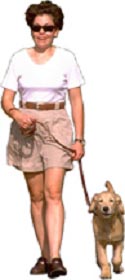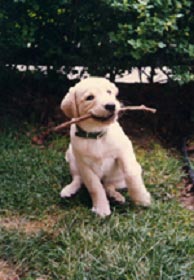Why
are play and exercise important?
Play
with owners and with other dogs,
not only provides the dog with
some of its exercise requirements,
but also helps to meet social
needs. Insufficient exercise
can contribute to problem behaviors
including destructiveness (chewing
and digging), investigative
behavior (garbage raiding),
hyperactivity, unruliness, excitability,
attention-getting behaviors,
and even some forms of barking.
It is especially important to
ensure that a dog's need
for exercise has been met prior
to leaving the dog alone at
home and prior to lengthy crating
or confinement sessions.
What
are good ways to play with and
exercise my puppy?
Taking
your dog for a walk is a good
way to accomplish exercise and
can be enjoyable and healthy
for you as well. From an early
age you should acclimate your
puppy to a collar and leash.
A flat nylon or leather collar
is fine. Keep your puppy away
from stray dogs and neighborhood
parks until all vaccinations
are finished. Practice your
walking skills in your own yard
first. Put your puppy on a leash
and with your voice and a small
tug, or perhaps a food or toy
reward as a prompt, encourage
it to follow you. Reward the
good behavior with praise. Keep
initial walks short to encourage
compliance.
Playing
with your pet is an enjoyable
activity for both of you. Not
only does the puppy get exercise,
but positive interactions take
place. Training sessions are
also an excellent way to gain
owner leadership and control,
while providing interaction
between you and your pet.
How
much exercise and play is appropriate?
Selecting
an appropriate amount and type
of play and exercise will depend
on the type of dog. Puppies
and even adult dogs from breeds
that have been bred for their
stamina or to do "work"
often have higher exercise requirements.
For purebred dogs, consider
their traditional work when
deciding the type and amount
of play to provide. For example,
the retrieving breeds do best
with lengthy games of fetch
or "Frisbee", while
the sledding breeds might prefer
pulling carts, or running or
jogging with an active owner.
The
length and type of play and
exercise for your dog will depend
on its behavioral requirements
and health limitations. While
some dogs may still be ready
for more after a five mile jog
and a game of fetch, others
may be tired and satisfied after
a short walk around the block.
How
can I keep my dog occupied when
I am away?
When
you are out, or you are busy
at home with other activities
and responsibilities, it would
be ideal for your dog to be
relaxed and sleeping, but this
will not always be the case.
Exploring the environment, stealing
food items, raiding garbage
cans, chewing or digging, are
just a few of the ways that
dogs will find to keep themselves
occupied. When you are confident
that you have provided your
dog with sufficient play and
interactive exercise, and you
must leave your dog alone, provide
sufficient toys and distractions
to keep your dog occupied and
confine your pet to a safe,
dog-proofed area. Some dogs
do best when housed with another
dog for play and companionship.
Others prefer objects to chew
(see our handout on ‘Destructiveness
– chewing'), areas
to dig (see our handout on ‘Destructiveness
– digging'), self
feeding toys, or even a video
to keep themselves occupied
and "busy" while
you are unavailable.
What type of play should be
avoided?
Try
to avoid games that pit your
strength against your puppies.
Tug-of-war games seem to be
an enjoyable diversion for many
puppies and they do help to
direct chewing and biting toward
an acceptable play object, rather
than an owner's hands
or clothing. On the other hand,
some puppies get very excited,
overly stimulated and become
far too aggressive during tug-of-war
games. A general rule of thumb
for tug-of-war (or any other
game for that  matter)
is to avoid it, unless you are
the one to initiate the game,
and can stop it as soon as the
need arises. Teaching the dog
to "drop" on command
can help to ensure that you
remain in control of object
play sessions such as fetch
and tug -of -war. (See our handout
on 'Controlling stealing and
teaching give'). A variety of
types of interactive toys are
also available for throwing,
retrieving, playing kickball
etc. matter)
is to avoid it, unless you are
the one to initiate the game,
and can stop it as soon as the
need arises. Teaching the dog
to "drop" on command
can help to ensure that you
remain in control of object
play sessions such as fetch
and tug -of -war. (See our handout
on 'Controlling stealing and
teaching give'). A variety of
types of interactive toys are
also available for throwing,
retrieving, playing kickball
etc.
Although
games like chase are good exercise,
they can often result in wild
exuberant play that gets out
of control. Again, a good rule
of thumb is to only play these
games, if you are the one to
initiate the game, and are capable
of stopping the game immediately
should it get out of control.
Many dogs can be taught to play
"hide and seek"
without becoming too excited.
Other dogs like to "search"
for their toys and bring them
to you.
How
can I teach my puppy to play
fetch?
Most
young puppies, even those that
do not have an inherent instinct
to retrieve, can be taught how
to play fetch from an early
age. You will need to train
your puppy to do three things;
go get the toy, bring it back,
and relinquish it to you so
that you can throw it again.
First, make the toy enticing.
Try a squeaky toy or a ball.
Toss the toy a short distance,
1-2 feet, and encourage your
puppy to go to it. When it gets
there give it praise. If your
puppy picks up the toy in its'
mouth, say ‘good dog'.
Then, move backwards a short
way, clap your hands and entice
your puppy to come towards you.
All the while you should be
encouraging verbally with a
happy tone of voice and lots
of praise. When your puppy returns
to you, say 'give it' or 'release'
and show another toy or even
a small food treat. Most puppies
will gladly give the toy to
get the new toy or treat and
at the same time will quickly
learn the ‘give'
or ‘release' command.
Then, by repeating the entire
sequence of events again, the
game of fetch itself, should
soon be enough of a reward that
food and toys will no longer
be necessary to entice the puppy
to give the toy. At the end
of each fetch play session,
have the puppy return the toy
and give a toy or chew treat
for the puppy to play with as
a final reward for releasing
the toy.
This
client information sheet is
based on material written by
Debra Horwitz, DVM, DACVB and
Gary Landsberg, DVM, DACVB.
© Copyright 2002 Lifelearn
Inc. Used with permission under
license. March 11, 2004. |